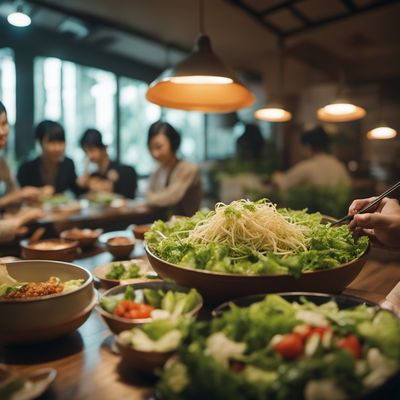
Recipe
Korean-inspired Sachertorte
Gochujang-infused Sachertorte: A Fusion Delight
4.8 out of 5
In the vibrant world of Korean cuisine, we have taken the iconic Austrian Sachertorte and given it a unique twist. This fusion dessert combines the rich flavors of chocolate and apricot with a hint of spicy gochujang, resulting in a delightful treat that seamlessly blends the best of both culinary traditions.
Metadata
Preparation time
30 minutes
Cooking time
45 minutes
Total time
1 hour 15 minutes
Yields
8 servings
Preparation difficulty
Medium
Suitable for
Vegetarian, Nut-free, Soy-free, Halal, Kosher
Allergens
Wheat, Eggs, Milk
Not suitable for
Gluten-free, Vegan, Dairy-free, Egg-free, Paleo
Ingredients
While the original Sachertorte is known for its dense chocolate cake and smooth apricot jam filling, our Korean-inspired version incorporates the bold and spicy flavors of gochujang, a traditional Korean chili paste. This addition adds a delightful kick to the classic dessert, creating a harmonious fusion of Austrian and Korean culinary influences. We alse have the original recipe for Sachertorte, so you can check it out.
-
200g (1 3/4 cups) all-purpose flour 200g (1 3/4 cups) all-purpose flour
-
200g (1 cup) granulated sugar 200g (1 cup) granulated sugar
-
200g (7 oz) unsalted butter, softened 200g (7 oz) unsalted butter, softened
-
200g (7 oz) dark chocolate, melted 200g (7 oz) dark chocolate, melted
-
6 large eggs, separated 6 large eggs, separated
-
1 teaspoon vanilla extract 1 teaspoon vanilla extract
-
1 tablespoon gochujang paste 1 tablespoon gochujang paste
-
200g (7 oz) apricot jam 200g (7 oz) apricot jam
-
100g (3.5 oz) dark chocolate, for glaze 100g (3.5 oz) dark chocolate, for glaze
-
100ml (1/2 cup) heavy cream, for glaze 100ml (1/2 cup) heavy cream, for glaze
-
Optional: crushed peanuts or sesame seeds for garnish Optional: crushed peanuts or sesame seeds for garnish
Nutrition
- Calories (kcal / KJ): 450 kcal / 1880 KJ
- Fat: 25g (total), 15g (saturated)
- Carbohydrates: 50g (total), 35g (sugars)
- Protein: 7g
- Fiber: 2g
- Salt: 0.2g
Preparation
-
1.Preheat the oven to 180°C (350°F). Grease and flour a round cake pan.
-
2.In a large mixing bowl, cream together the softened butter and sugar until light and fluffy.
-
3.Add the melted dark chocolate to the butter mixture and mix well.
-
4.Beat in the egg yolks, one at a time, followed by the vanilla extract and gochujang paste.
-
5.In a separate bowl, whisk the egg whites until stiff peaks form.
-
6.Gently fold the egg whites into the chocolate mixture until well combined.
-
7.Pour the batter into the prepared cake pan and smooth the top.
-
8.Bake for approximately 40-45 minutes, or until a toothpick inserted into the center comes out clean.
-
9.Allow the cake to cool in the pan for 10 minutes, then transfer it to a wire rack to cool completely.
-
10.Once the cake has cooled, slice it horizontally into two equal layers.
-
11.Spread a generous layer of apricot jam on the bottom layer and place the second layer on top.
-
12.In a small saucepan, heat the heavy cream until it begins to simmer.
-
13.Remove from heat and add the dark chocolate. Stir until the chocolate is completely melted and the glaze is smooth.
-
14.Pour the glaze over the assembled cake, allowing it to drip down the sides.
-
15.Optional: Sprinkle crushed peanuts or sesame seeds on top for garnish.
-
16.Allow the glaze to set before serving.
Treat your ingredients with care...
- Gochujang paste — Adjust the amount according to your spice preference. Increase or decrease the quantity to achieve the desired level of heat.
- Dark chocolate — Use high-quality dark chocolate with at least 70% cocoa for the best flavor and texture.
- Apricot jam — Choose a smooth and high-quality apricot jam for a delicious filling.
Tips & Tricks
- For a more intense gochujang flavor, mix a small amount of gochujang paste with the apricot jam before spreading it on the cake layers.
- Serve the Sachertorte with a dollop of whipped cream or a scoop of vanilla ice cream to balance the spiciness of the gochujang.
- If you prefer a smoother glaze, strain the melted chocolate and cream mixture before pouring it over the cake.
- Store the Sachertorte in an airtight container at room temperature for up to 3 days.
- This dessert pairs well with a cup of Korean green tea or a refreshing glass of iced barley tea.
Serving advice
Slice the Korean-inspired Sachertorte into generous portions and serve it on individual dessert plates. Garnish each slice with a sprinkle of crushed peanuts or sesame seeds for added texture and visual appeal. Accompany the cake with a small bowl of whipped cream or a scoop of vanilla ice cream for a delightful contrast of flavors and temperatures.
Presentation advice
To present the Korean-inspired Sachertorte beautifully, place a slice of the cake on a dessert plate. Drizzle a small amount of the glaze around the plate in an artistic manner. Add a dollop of whipped cream or a scoop of vanilla ice cream on the side. Sprinkle some crushed peanuts or sesame seeds on top of the cake slice for an elegant finishing touch.
More recipes...
For Sachertorte » Browse all
For Austrian cuisine » Browse all
More Austrian cuisine dishes » Browse all

Kaspressknödel
Kaspressknoedel
Kaspressknödel is a traditional Austrian dish made with bread, cheese, and onions. It is a hearty and filling meal that is perfect for cold winter nights.

Biedermeier-Torte
Biedermeier-Torte is a traditional Austrian cake that is made with layers of sponge cake, apricot jam, and a chocolate glaze. The cake is named...

Linzer Augen
Linzer Eyes
Linzer Augen are a traditional Austrian cookie that is made with a combination of flour, sugar, ground almonds, and raspberry jam. These cookies...
More Korean cuisine dishes » Browse all

Maejakgwa
Maejakgwa is a traditional Korean dessert that is typically enjoyed during the holidays or special occasions. It is known for its crispy texture...

Saengchae
Saengchae Salad
Saengchae is a Korean salad made with fresh vegetables and a spicy dressing. It is a refreshing and healthy dish that is perfect for a summer day.

Nakji bokkeum
Spicy Octopus Stir-Fry
Nakji bokkeum is a Korean dish made with stir-fried octopus and vegetables. It is a spicy and flavorful dish that is often served with rice.









